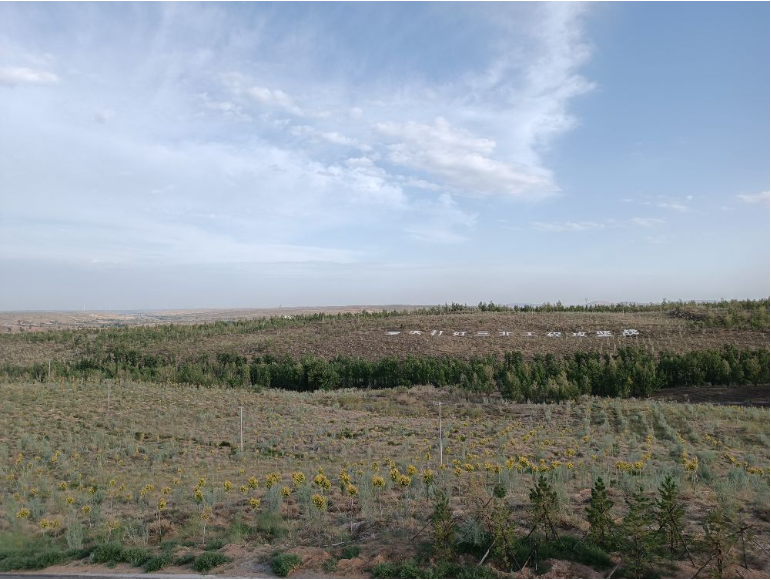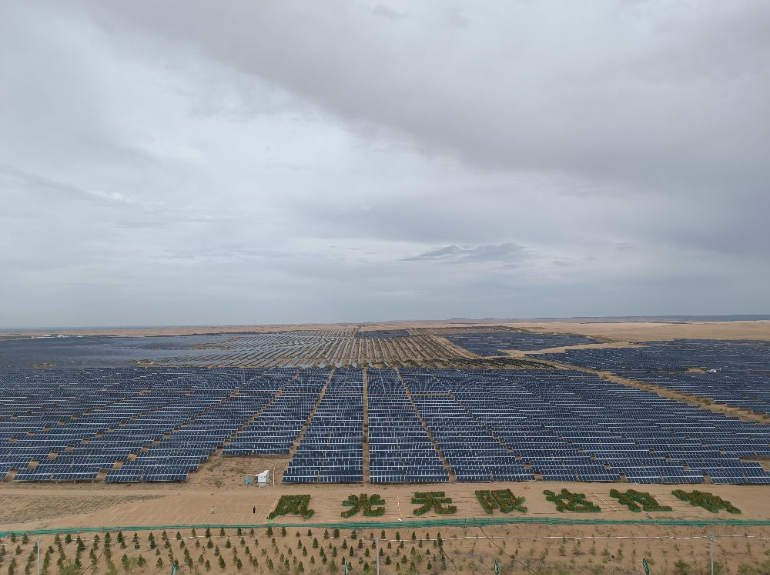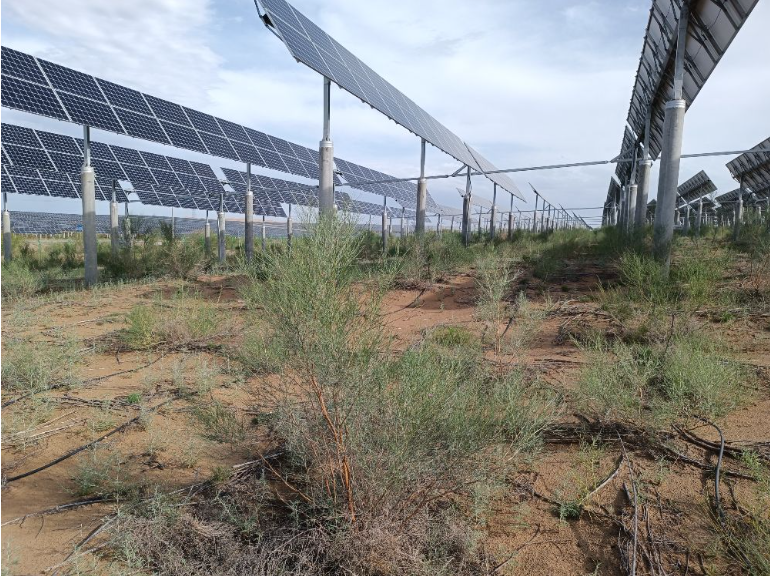Urban Innovation in China | “The Oasis of Golden Sands and Blue Waters”, Ordos’s ecological account book
Song Xianlei, the deputy director of Ordos Afforestation General Farm, stood on the observation deck of the Yinkentala Comprehensive Management Zone, pointing to a sea of green from near to far. He could not help but say “The area in front of us is the poplar trees planted in the 1980s, lush and vibrant. They have taken root firmly for forty years now.”
No one would have thought that 40 years ago, this place was still an endless sandy area, known as the “Sea of Death” by local residents, with no birds in the sky and no grass on the ground. As one of the areas with worst conditions in the Kubuqi Desert, the seventh largest desert in China, Yinkentara Desert in Dalat Banner is smack in the middle of the Kubuqi Desert. During the wind seasons in winter and spring, it will be swept by yellow sands allover, which once destroyed a large part of the oasis and crops.
In order to restore the oasis, sand control workers have practiced sand control and afforestation for more than 40 years. Nowadays, the ecological governance of Yinkentala has become the model for sand control in Ordos. In September 2017, the Thirteenth Conference of the Parties to the United Nations Convention to Combat Desertification was held in Ordos. Back then, representatives from various countries showcased the wisdom and model of Dalat Banner in desertification governance to the world.
This is just a microcosm. In recent years, Ordos in Inner Mongolia Autonomous Region has implemented various incentive mechanisms to encourage and guide enterprises and farmers and herdsmen to participate in sand prevention and control through contracting, shareholding, leasing, as well as labor investment. Not only has it achieve fruitful results in sand control and green development, but it has also innovatively initiated the “photovoltaic sand control” mode. As a result, “the Oasis of Golden Sands and Blue Waters” that combines scientific and technological innovation and enriches people by ecological construction was created, driving more than 300,000 farmers and herdsmen to increase production and income.
On June 19, a “Here Lies Happiness” themed visit event was hosted in Inner Mongolia Autonomous Region, which was organized by the State Council Information Office and undertaken by the Inner Mongolia Autonomous Region Government Information Office. In this event, internet celebrities from home and abroad were invited to visit Dalad Banner, Ordos and cross along roads through the sand to the Yinkentala Comprehensive Management Zone and Dalate Banner Photovoltaic Power Generation Park. Through interviews, the ecological account book of Ordos’ high-quality development was unveiled.
Sample of “Three Wins” in Sand Prevention and Control
Founded in 1978, Ordos Afforestation General Farm is one of the key construction units of Three-North Shelterbelt Forest Program (TSFP) established by the state.
Through the exploration and efforts of several generations of sand control workers, Ordos Afforestation General Farm has completed a total of 1.72 million mu of forestry ecological construction tasks ant the forest and grass coverage rate has increased from 6.3% in the early stage of construction to 80% today. A green windbreak and sand fixation forest system combining trees, shrubs, grass, and mesh has been built in the middle section of the Kubuqi Desert, which has effectively curbed the northward expansion and eastward movement of the desert.

Create a woodland where “trees, shrubs and grass, or their combinations, are well leveraged to fit in different land conditions”
Song Xianlei told Southern Finance Omnimedia Corp. that “Looking back on the experience of sand prevention and afforestation in our farm, the main approach is to adopt the mode of ‘first near and then far, front control and back blocking, surrounding all sides and flourishing in the middle.’ Besides, we also need to act accordingly so that ‘trees, shrubs and grass, or their combinations, are well leveraged to fit in different land conditions.’”
According to Song, with technology as a support, the forest farm has promoted the application of a series of practical afforestation technologies such as front blocking and back pulling, afforestation by sand removal, afforestation by aerial seeding, afforestation by sand fixing, mechanical drilling and deep planting as well as stem cutting and deep planting for moisturizing, drought resistant and afforestation. “Desert forests that were once difficult to survive can now be able to reach a survival rate of 90%.” he said.
With the continuous expansion of the green area, the forest farms have begun to transition from traditional afforestation to management and protection. Aiming at new economic growth points for the development of the forest and sand industry, the farm has successfully realized the virtuous cycle of the sand economy, thus resulting in a virtuous cycle of ecological and economic benefits and a reasonable layout of its long-term development and short-term benefits.
For example, with 40 years of experience in running the field, Ordos Afforestation General Farm has broken the traditional model of afforestation and firmly grasped the opportunity of the construction of three industries: seedling distribution bases, understory economy, and desert ecological tourism. It has successfully embarked on a path of “fully utilize forest resources to achieve economic benefits” so as to bring dormant green resources to life.
“Nowadays, our forest farm has become a base for many scientific research institutes to apply and promote scientific and technological achievements, as well as for educational researches for young people. In 2007, our forest farm established the only sand willow germplasm resource conservation database in the country. Every year, tourists from all over the country come to visit, with an average of more than 5,000 visitors per day in peak seasons.” Song Xianlei revealed that thanks to this, the forest farm has also realized growth in economic, ecological, and social benefits.
Pursue both “golden content” and “green content”
Heading from Yinkentala Desert to the west, “blue waters” suddenly appeared in the vast sand sea as we went all the way deep into the hinterland of the Kubuqi Desert. There lied the Dalat Banner Photovoltaic Power Generation Application Leading Base.
Standing on the 12-storey high observation deck, the blue photovoltaic panels perched majestically in the sand sea, with rows of photovoltaic panels like fish scales arrayed in the middle of the Kubuqi Desert shining brightly under the sunlight. Under the panel, sand plants are spitting out new green, forming a sharp contrast with the desert and in the distance.
The construction scale of the Dalat Banner Photovoltaic Base is 1 million kilowatts, and it has been fully built and connected to the grid, with an annual green power generation of 2 billion kilowatt hours. The first phase of New Energy Base in the central and northern part has been completed and connected to the grid in 2023, while the second phase of 1 million kilowatts is planned to be connected to the grid by the end of 2024.
“The Dalat Banner Photovoltaic Base is only one of the projects of ‘Photovoltaic Great Wall’ in the Kubuqi Desert that Ordos is planning to build” Zhong Yuzhan mentioned, the deputy director of the Dalat Banner Energy Bureau. “Photovoltaic Great Wall” covers an area of 400 kilometers long from east to west, with an average width of 5 kilometers to accommodate 100 million kilowatts of installed capacity, and achieve 3 million mu of photovoltaic desertification control and 9 million mu of ecological desertification control.
Ordos, located in the transitional zone between arid and semi-arid regions, has the Kubuqi Desert in the north, the Mu Us Desert in the south, hilly and gully areas in the east, and undulating plateau hard beam areas in the west. The average annual precipitation is only 150 to 350 millimeters, but the evaporation is 2000 to 3000 millimeters. It is one of the areas with severe desertification and soil erosion in Inner Mongolia Autonomous Region and even in China.
“In this Photovoltaic Great Wall, there are projects such as the Kubuqi South Base Project, the Kubuqi Central North Base Project as well as the Dalat Banner Photovoltaic Base. The projects are scheduled to be completed by 2030. By then, the photovoltaic power generation will also be equipped to transmit approximately 44 billion kilowatts of electricity to the Beijing-Tianjin-Hebei Urban Agglomeration every year.” Zhong also mentioned that the Photovoltaic Great Wall aims to prevent and stabilize sand, reduce the inflow of Yellow River sediment, and protect our mother river.

Dalat Banner Photovoltaic Power Generation Application Leading Base
“At present, we have invested 3.5 billion yuan and can generate 1million kilowatts of photovoltaic power with a full life cycle of 25 years. We may recover costs approximately in the 9th year as the benchmark on-grid price is 0.28 yuan per kilowatt hour. According to Zhong Yuzhan’s introduction, in addition to power generation, photovoltaic power has made significant achievements in sand prevention and fixation, and can also drive the agricultural economy in deserts.
“Electricity can be generated on the panels, and cultivation and breeding can be carried out under the panels. As photovoltaic panels reduce water evaporation caused by sunlight, the survival rate of desert plants planted under the panels is improved. High quality forage, medicinal herbs such as astragalus membranaceus and Scutellaria baicalensis, and economic crops like potatoes can be planted. When they are ripe, chicken and sheep can also be raised among the panels.” Zhong believes that the “photovoltaic sand control” mode in Dalat Banner has achieved both “golden content” and “green content”.

Photovoltaic panels reduce water evaporation from direct sunlight
At present, projects of sand prevention and control and the construction of wind and photovoltaic integration in Ordos are in full swing. By synchronously implementing photovoltaic sand control and supporting ecological governance projects, the Photovoltaic Great Wall has been built. In the future, this “Great Wall” will not only serve as the “Great Wall of Ecology” and “Great Wall of Green Power”, but also the “Great Wall of Industry and Innovation that brings prosperity”.
Author: Li Zhen, journalist of the Southern Finance Omnimedia Corp.


 In Focus | World Cities Day: People-Centred Smart Cities
In Focus | World Cities Day: People-Centred Smart Cities City Stories | Fostering community resilience: A lifeline for the Central African Republic
City Stories | Fostering community resilience: A lifeline for the Central African Republic In Focus | Innovative Education, Empowering Futures
In Focus | Innovative Education, Empowering Futures




















 Tel: +86 020 3780 4434
Tel: +86 020 3780 4434 Email: info@guangzhouaward.org
Email: info@guangzhouaward.org Adress: Unit 01-7, 28th Floor, No. 7, Chunrong 3rd Road, Tianhe District, Guangzhou, Guangdong, 510000, PRC
Adress: Unit 01-7, 28th Floor, No. 7, Chunrong 3rd Road, Tianhe District, Guangzhou, Guangdong, 510000, PRC




